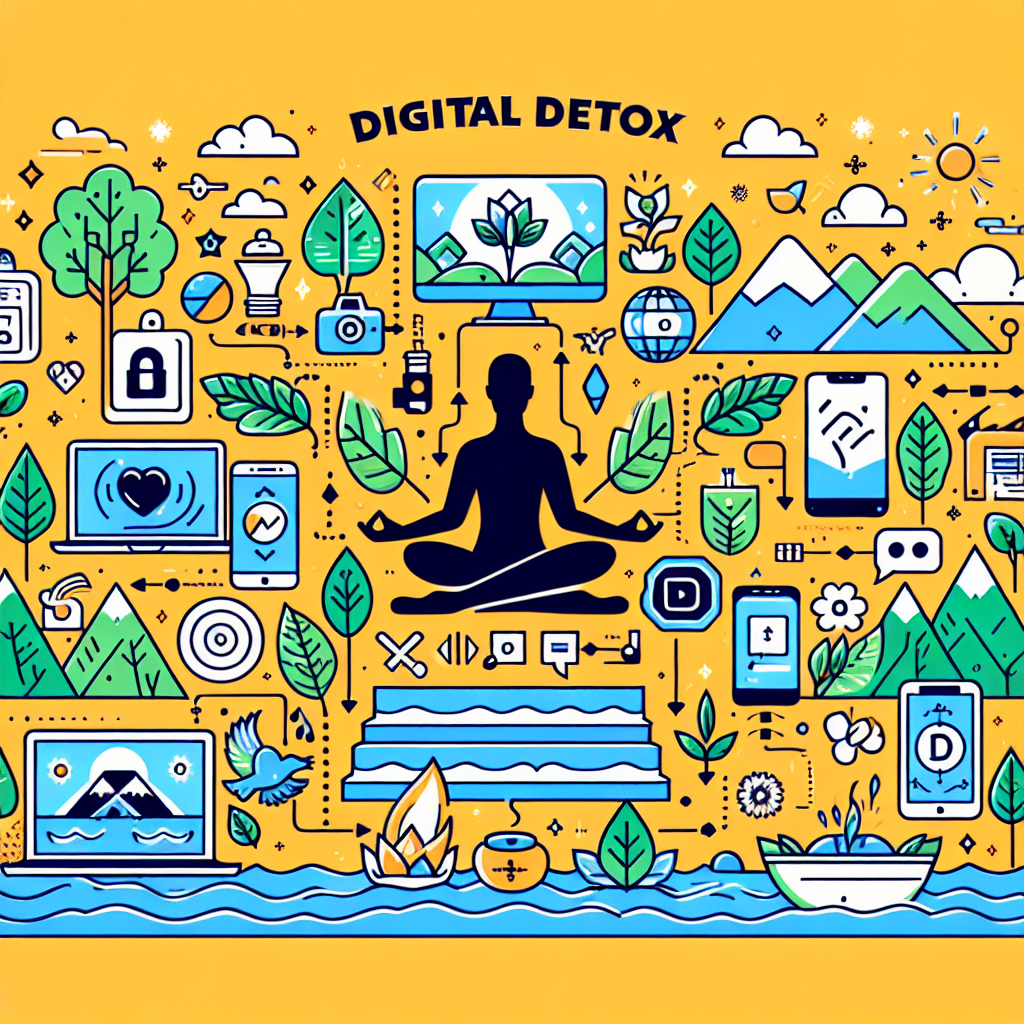How to Do a Digital Detox That Actually Works

Ready to reclaim your time and focus from digital distractions? Learn how to do a digital detox that actually works. Start your journey towards a balanced digital life today. Click here to get started.
Effective Strategies for a Successful Digital Detox
In today’s digital age, we are constantly bombarded with information from various sources, including social media, emails, and news updates. This constant connectivity can lead to feelings of overwhelm, stress, and anxiety. One solution to this problem is a digital detox, a period of time during which a person refrains from using electronic devices. However, for a digital detox to be effective, it needs to be done correctly. Here are some strategies that can help you achieve a successful digital detox.
Firstly, it’s important to set clear and realistic goals for your digital detox. This could mean completely abstaining from using any digital devices for a certain period of time, or it could mean limiting your use of certain apps or websites. Whatever your goals are, make sure they are achievable and measurable. For example, instead of saying “I will use my phone less,” say “I will only use my phone for one hour each day.” This way, you can easily track your progress and stay motivated.
Next, prepare for your digital detox by informing others about your plans. Let your friends, family, and coworkers know that you will be less available during your detox period. This can help prevent any misunderstandings or feelings of guilt for not responding immediately to messages or emails. Additionally, consider setting up automatic responses on your email and social media accounts to let people know when they can expect a response from you.
Another effective strategy is to replace your digital activities with offline activities. Instead of scrolling through social media or watching TV, read a book, go for a walk, or engage in a hobby. This can help you break the habit of reaching for your phone or computer whenever you have a free moment. Plus, it can help you discover new interests and hobbies that you may not have considered before.
Furthermore, create a conducive environment for your digital detox. This could mean turning off notifications on your devices, keeping your phone in another room, or even using a traditional alarm clock instead of your phone to wake up in the morning. By removing these digital distractions, you can focus more on your offline activities and less on what’s happening online.
Lastly, be patient with yourself. A digital detox can be challenging, especially if you’re used to being constantly connected. It’s normal to feel anxious or restless at first, but these feelings will likely subside as you adjust to your new routine. Remember, the goal of a digital detox is not to completely eliminate technology from your life, but to create a healthier relationship with it.
In conclusion, a successful digital detox requires clear goals, preparation, replacement of digital activities with offline ones, a conducive environment, and patience. By implementing these strategies, you can reduce your reliance on digital devices, decrease feelings of stress and anxiety, and improve your overall well-being. So why not give it a try? You might be surprised at how refreshing a break from the digital world can be.
Mastering the Art of Digital Detox: A Comprehensive Guide

In today’s digital age, we are constantly bombarded with information from various sources, including social media, emails, news, and more. This constant digital engagement can lead to stress, anxiety, and a lack of focus. To combat this, many people are turning to a digital detox, a period of time during which a person refrains from using electronic devices. However, for a digital detox to be effective, it must be done correctly. This article will provide a comprehensive guide on how to master the art of digital detox.
Firstly, it is important to understand that a digital detox is not about completely eliminating technology from your life. Rather, it is about creating a healthier relationship with technology. This means setting boundaries and using technology in a way that enhances your life rather than detracts from it.
To begin your digital detox, start by identifying the digital activities that consume most of your time and energy. These could be anything from scrolling through social media, checking emails, or watching videos online. Once you have identified these activities, you can start to limit your usage.
One effective strategy is to set specific times during the day for these activities. For instance, you could designate an hour in the morning and an hour in the evening for checking emails and social media. Outside of these times, try to refrain from these activities. This not only helps to reduce your overall screen time but also allows you to be more present and focused on the task at hand.
Another key aspect of a successful digital detox is replacing digital activities with offline activities. This could be anything from reading a book, going for a walk, practicing yoga, or spending time with loved ones. By replacing digital activities with offline activities, you are not only reducing your screen time but also engaging in activities that are beneficial for your mental and physical health.
It is also important to create a digital-free zone in your home. This could be a specific room or a certain area where no electronic devices are allowed. This helps to create a physical separation between you and your devices, making it easier to disconnect.
While doing a digital detox, it is crucial to be patient with yourself. It is normal to feel anxious or restless when you first start reducing your screen time. However, with time, you will start to notice the benefits of a digital detox, such as improved focus, reduced stress, and better sleep.
Lastly, remember that a digital detox is not a one-time event but a lifestyle change. It is about creating long-term habits that promote a healthier relationship with technology. Therefore, it is important to regularly reassess your digital habits and make adjustments as needed.
In conclusion, mastering the art of digital detox involves identifying and limiting time-consuming digital activities, replacing digital activities with offline activities, creating a digital-free zone in your home, being patient with yourself, and making it a lifestyle change. By following these steps, you can create a healthier relationship with technology and improve your overall well-being.
Achieving Balance: Practical Steps to a Successful Digital Detox
In today’s digital age, our lives are increasingly intertwined with technology. From smartphones to laptops, tablets to smartwatches, we are constantly connected. While these devices offer numerous benefits, they can also lead to digital overload, causing stress, anxiety, and even physical health issues. To combat this, many people are turning to a digital detox, a period of time during which a person refrains from using electronic devices. However, for a digital detox to be truly effective, it must be approached in a balanced and practical manner.
The first step towards a successful digital detox is to identify your digital habits. This involves understanding how much time you spend on your devices, what you use them for, and how they impact your life. You can do this by keeping a digital diary for a week, noting down every time you use a device, what you use it for, and how you feel afterwards. This will give you a clear picture of your digital usage and help you identify areas where you can cut back.
Once you have identified your digital habits, the next step is to set clear and achievable goals for your detox. These goals should be specific, measurable, achievable, relevant, and time-bound (SMART). For example, you might aim to reduce your daily screen time by two hours, or to only check your emails twice a day. By setting SMART goals, you can ensure that your detox is both challenging and achievable.
After setting your goals, the next step is to create a digital detox plan. This should include strategies for achieving your goals, such as turning off notifications, setting device-free times, or using apps that limit screen time. It’s also important to plan for potential challenges, such as boredom or withdrawal symptoms. You might want to prepare a list of non-digital activities to keep you occupied, or strategies for dealing with cravings.
Once your plan is in place, the next step is to implement it. This involves putting your strategies into action and sticking to your goals. It’s important to be patient with yourself during this stage, as changing habits can take time. If you slip up, don’t beat yourself up. Instead, use it as a learning experience and adjust your plan if necessary.
Finally, it’s important to regularly review your progress. This involves checking in with yourself to see how you’re doing, and adjusting your plan if necessary. You might find that some strategies work better than others, or that your goals need to be adjusted. By regularly reviewing your progress, you can ensure that your detox is effective and sustainable.
In conclusion, a successful digital detox involves identifying your digital habits, setting clear and achievable goals, creating a digital detox plan, implementing your plan, and regularly reviewing your progress. By approaching your detox in a balanced and practical manner, you can reduce your digital overload, improve your mental and physical health, and enhance your overall quality of life. Remember, the goal of a digital detox is not to completely eliminate technology from your life, but to create a healthier relationship with it.